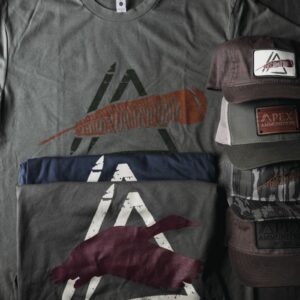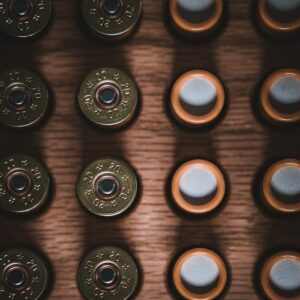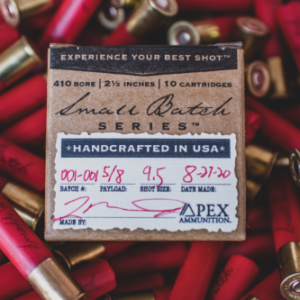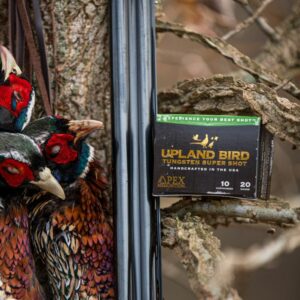By: Nick Charney
The modern shotshell cartridge has come a long way from the product that is commonly used today. The current brass head, plastic casing, one-piece wad and variety of shot options have been engineered over time out of reliability, regulation and economical need. The history of shotshells dates back to around the early to mid-1800s where cartridges were used to expedite the loading of muzzeloading shotguns primarily used by the military. (Butler, p.171). In the early stages, they consisted of a brass casing with packages of black powder, shot and paper/fiber wads in breach loading guns. It wasn’t until the 1850’s that the first centerfire primers were developed in France and the year’s following after became exceptionally popular all across Europe, and then into America. (McLauglin, p.5). However, as these shotshells became prominent in Europe, they were often expensive as new technology is, which created a conundrum between European shooters and Americans.
Hand loading shotshells has always been a staple in American shotgunning. As the social class of shooters in Europe differed very much of that compared to Americans, the need for an in-expensive, reliable and fast loaded cartridge began to overtake the innovation mindset. (McLauglin, p.5). Factory loaded ammunition at the time was very expensive and thus was only afforded to the affluent. In the 1860’s and 1870’s, several advancements began to come from American pioneers. One of which, came from a dentist named Dr. Edward Maynard. His early contributions focused on directing the ignition from the primer through passages of a brass case to ignite the black powder, which subsequently led to his design of a self-primed cartridge. As other innovate solutions in conjunction continued to emerge from the industry, the end goal was to make a cartridge casing that could be loaded quickly, affordably and with relative ease for the needs of the American shooter, which hunted for food and market.
In the early stages, brass casings were the predominant means of creating the re-usable and reliable cartridge. Early prototypes of the brass casing transitioned from multiple pieces threaded together to ultimately one-piece design. In addition, self-contained primers were added to the design which created the overall casing. To contain the shot, two methods were used at this point. One, was a smooth round edge that would be used to “roll” the brass over what we call the modern day “overshot card.” This would be the equivalent to what we see in terms today as a, “roll crimp.” The other was a serrated type edge that created tab like fingers that could be folded over to contain the shot. (McLaughlin, p.7). As with all metal, these became worn out and often times would break resulting in the use of the rolled brass over an overshot type card to contain the shot. Since this era predominately used black powder, with proper maintenance and care, these brass casings could be used almost indefinitely due to the relatively low pressures generated by black powder. With the use of modern day smokeless powders, this would not be the case today as we see rifle and handgun brass used a finite amount of times before their expiration.
Along side the brass shell, the invention of a paper hull also began to emerge as it was designed to be seated into a brass style heading as a more economical option in the late 1800’s. In today’s terms of shotgunning, a brass cartridge would rival that of the cost of rifle ammunition we see today, so the paper hull option paved the way for an economical and profitable means to offer factory loaded ammunition. While the brass heading was kept in place in a shorter height, which we still see today, the intent is to cover the powder charge to strengthen the structural integrity of the cartridge. As this shotshell body began to evolve to become more widely available, so did advancements in gun powder.
In the 1800s as well, French alchemists are credited with the development of smokeless powders as an alternative to black powder. Smokeless powder in nature is a propellant while black powder is classified as an explosive. It is a propellant because the primer ignites the propellant via flame, as opposed to older percussion caps relied on shock sensitive explosive substance chemicals to force the black powder to “explode.” Smokeless powder, while it does create some “smoke” burns substantially cleaner than black powder and is 3 times as powerful.
However, two things were learned early on with this new technology. One, it was hard to ignite and therefore American re-loaders would place small amounts of black powder over the primer to help the ignition. This technique is seldom used in today’s environment, more so with hand packed muzzeloading shotguns using a “hotter” burning powder to assist the slow burning powder. The second, is that due to the increased pressure generated from smokeless powder, the metal properties of 19th Century shotgun barrels were not often equipped to handle the increased stress. While the smokeless powder we use today has many chemical advancements compared to its initial invention, the American hunting shotshell continued to evolve as modern smokeless powders began to gain popularity and overtake the market.
As the Industrial Revolution was in full swing, ammunition manufacturers were able to source materials and manufacture components themselves to design and create factory loaded ammunition. While hand loading at the time under brass shotshells was economically cheaper than purchasing factory made, the means and materials as paper hulls and smokeless powder emerged created a sustainable and viable market. It soon became more economical to purchase factory-loaded ammunition for the average American than it did to reload. Around the 1920s, shotshells were predominately comprised of a centerfire primer pocket, a brass head, paper tubing (hulls with possible additions of liners), smokeless powder, and fiber wadding above and below the lead shot. It was from here until post WWII in the 1950s that most advancements in shotshells were primarily made into the primers and smokeless powder for increased efficiency and reliability.
Post WWII, the surge in development and use for plastic was drastically on the rise. In the late 1950’s, the first plastic hull (polyethylene plastic) was invented and soon after over took the paper hulls. At the same time, almost in conjunction but two separate entities, a company named Alcan and a gentleman named Robert Comerford are credited with the development of the one-piece plastic wad system around that time. Traditionally, up until this point, wadding consisted of a fiber material over the powder that separated the shot and another piece placed over the shot and roll crimped to contain the shot. With the development of a one-piece wad, the economics, rate, ease of loading and ultimately gains in pattern retention began to increase dramatically. Even with the addition of plastic wads, these shotshells still placed an overshot card device on top and were roll crimped. Shortly after as plastic began to overtake the hull and wad systems, the fold crimp emerged as it was deemed easier to contain the shot, used the existing plastic and cost efficiently reduced the need for an overshot card. At this point, until the ban of lead in 1991 for waterfowl, centerfire self-contained primers, modern smokeless powder, plastic one-piece wads and roll or fold crimps comprised the American hunting shotshell.
Up until the ban, the predominant shot type used was lead. It was affordable, readily available, easy to manufacture, and it was very effective. As agencies and non-profit organizations began to study the effects of lead, they began to assess the environmental impacts it had on animals, particularly migratory waterfowl and other wildlife species with respect to their health and reproductive systems. As a result, while the study is still considered controversial to some that led to the end result, the U.S. Fish & Wildlife agency phased in the ban of lead shot for migratory birds in the 1987-1988 hunting seasons with the ban becoming nationwide in 1991. This created a dynamic shift in the waterfowl hunting world and ultimately other states and public land entities where lead has now been banned out right. As alternative options, bismuth and steel shot began as replacements however, the problem was that everything was more expensive than lead and less density. Lack-luster performance coupled with increased pricing created a problem but also a new opportunity for ammunition manufacturers. One solution, was generated in 1988 that created the 3 ½” 12 gauge shotgun shell to holder heavier payloads of larger steel pellets as the ban began to take start. Subsequently as well, a new chapter of innovation was carved for the quest for developing affordable, sustainable, and economical non-toxic shot options to replace lead.
The invention of the 3 ½” shotgun shell, as well as advancements over the years prior into low carbon high-tensile strength steel for barrels made steel shot an option. However, it was less dense than lead (7.8g/cc versus lead at 11.34g/cc) which resulted in the need for larger pellets and heavier payloads to account for the lost in pattern, as well as increased powder charges for additional velocity needed for energy retainment. Another issue was that since steel shot was the next best economical alternative, it also cemented the need for one-time use plastic wads. Since steel shot is as hard as the gun barrel (as well as many other non-toxic shot types but not all), and unable to be used in some older shotguns not designed to handle the chamber pressures associated, the plastic wad was required in order to prevent the shot from contacting the barrel and prevent scoring.
This also created a problem for the smaller guns which lacked the ability to carry an effective payload due to their shorter chamber design and the investment into non-toxic shot options began to form to not only offer lead-like density USFWS non-toxic approved shot options to combat steel, but to reinvigorate the smaller gauges. At the turn of the 20th Century, the push for tungsten like alloys, with different ratios of materials to create a variety of densities began to emerge. This began a major industrial shift into tungsten alternatives for shot that could be economical, but make up for the loss in performance of lead shot. Since the first application of tungsten alloys at the start of the 21th Century, 10 out of 14 current USFWS non-toxic approved shot types have some form of tungsten combined to create lead-free alternatives. The rest are comprised of Copper, Iron (Steel Shot), or Bismuth. While each material and their respective subsequent options have their advantages and disadvantages, they all bring a compilation on non-toxic shot alternatives to the American Hunter designed to offer performance for every shooter, 10 gauge to 410 bore and everything in between.
The American shotshell has widely evolved over the last decade and a half. While there are countless other innovations that occurred along the way such as buffered shot, copper plating lead, non-corrosive primers, increased chamber lengths, etc., it is important to note that as time progressed, major shifts in industrial advancement and government regulation shaped the modern day shotshell cartridge. From the days of percussion caps, brass cases, black powder with fiber wads all the way to the modern self-contained non-corrosive primers using smokeless powders with plastic hulls, wads and non-toxic alloys, these innovations have shaped the American hunting shotshell and further makes us marvel the options we have readily available in today’s market.
Works Cited
Butler, David F. The American Shotgun. Lyman Publications: Middlefield, CT: 1973.
McLauglin, James. The Evolution of the Shotshell. 1983.








